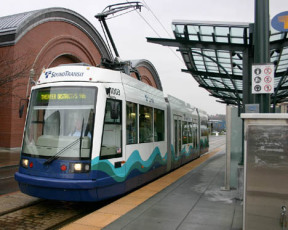Are you headed to Sea-Tac airport?
If city leaders get their way, soon you will be able to travel via Link light rail from downtown Tacoma to catch your flight.
How about a quick connection to Tacoma Community College?
That, too, is on the city’s wish-list of projects for Sound Transit — namely, extending Link west to the growing community college.
These are two of more than a dozen potential Sound Transit projects in Pierce County that Tacoma City Councilmembers and Sound Transit Boardmembers are evaluating, according to a discussion during Tuesday’s city council study session.
These projects are part of Sound Transit 2 — a plan approved by the board last July to expand mass transit in Puget Sound. Over the past six months, the transportation agency has collected input from five regional sub-areas — Snohomish, Seattle / North King, East King, South King, and Pierce counties — and is narrowing down its list in order to present a ballot measure to fund the projects.
Other Tacoma and Pierce County projects on the list?
Expand parking at Tacoma Dome Station, build a new parking garage and pedestrian bridge at South Tacoma Station, and swap the small Tacoma Link cars that travel through downtown Tacoma with larger, high-capacity Central Link cars.
But a connection between downtown Tacoma and Sea-Tac airport is at the top of the list at City Hall. Tacoma Mayor Bill Baarsma, in a letter last year to the Sound Transit board, said that anything less was not a solution to the city’s transportation needs.
During Tuesday’s meeting, Councilmember Tom Stenger echoed that concern.
”We want it to be just as easy to get to downtown Tacoma from Sea-Tac as it is to get to downtown Seattle,” he said. ”We want equality there.”
To that end, Stenger wants to see Tacoma Link’s trains upgraded to the higher-capacity cars required to reach Sea-Tac airport so that passengers won’t have to change trains at Tacoma Dome Station before traveling north. “It’s important to stress the one trip, one seat rule,” he said. “The more difficult you make it, the less ridership there is.”
But Councilmember Rick Talbert viewed Tacoma Dome Station as a hub for several transportation options from which riders can choose. He disagreed with Councilmember Stengers one trip, one seat concern.
”There’s an anticipated reality that to get from point A to point B, you have to go through point C and point E,” said Councilmember Talbert. “If Tacoma Dome Station is the terminus of the Sea-Tac/Tacoma line, and there are other transportation options, that seems fine to me.”
While the Sea-Tac / Tacoma connection is a top priority, not every project has made Sound Transit’s cut.
One example: a station at 11th and Commerce downtown, championed by Councilmember Bill Evans. Currently, Link runs along Commerce Street with one stop at 15th Street and another stop at 8th Street, in the Theater District. “To go for seven long blocks without a stop doesn’t serve the population base well,” said Councilmember Evans. ”I’d really like to cry out for that stop at 11th and Commerce.”
Councilmember Jake Fey agreed.
“It’s not appropriate for us to have a seven- or eight-block gap,” he said. “It puts people in an edge of town where we need to do some work to revitalize it.”
The capital cost for adding a station is $2 million. But Sound Transit representatives argue that if Link cars are swapped for larger, longer, and higher-capacity cars — a requirement for expanding service to Sea-Tac airport — traffic along Commerce Street and through downtown would be impacted.
Another example: connecting Sound Transit to Tacoma Mall. Currently, none of Sound Transit’s lines of business — express buses, Link light rail, or Commuter trains — reach the mall.
“I think Tacoma Mall should be mentioned because it’s an economic engine,” said Councilmember Evans.
The city will continue to discuss Sound Transit 2 through March. Sound Transit hopes to finalize its list of projects later this year.
Tacoma has set a precedent of sorts for Sound Transit. Tacoma Dome Station is the only location in Sound Transit’s jurisdiction that serves the agency’s three lines of business.
Sound Transit was created in 1996, when voters in the urban areas of King, Pierce and Snohomish counties approved the local taxes to create Sound Transit. The agency is tasked with building and operating a regional mass transit system connecting the three-county Sound Transit district. The system includes a mix of mass transit improvements: high-occupancy vehicle (HOV) lane access improvements; ST Express bus routes; Sounder commuter rail; and Link light rail.
Sound Transit 2 stems from the agency’s desire to meet future growth and transportation demands. According to Sound Transit, Puget Sound is expected to grow by 1.2 million people over the next 20 years.










